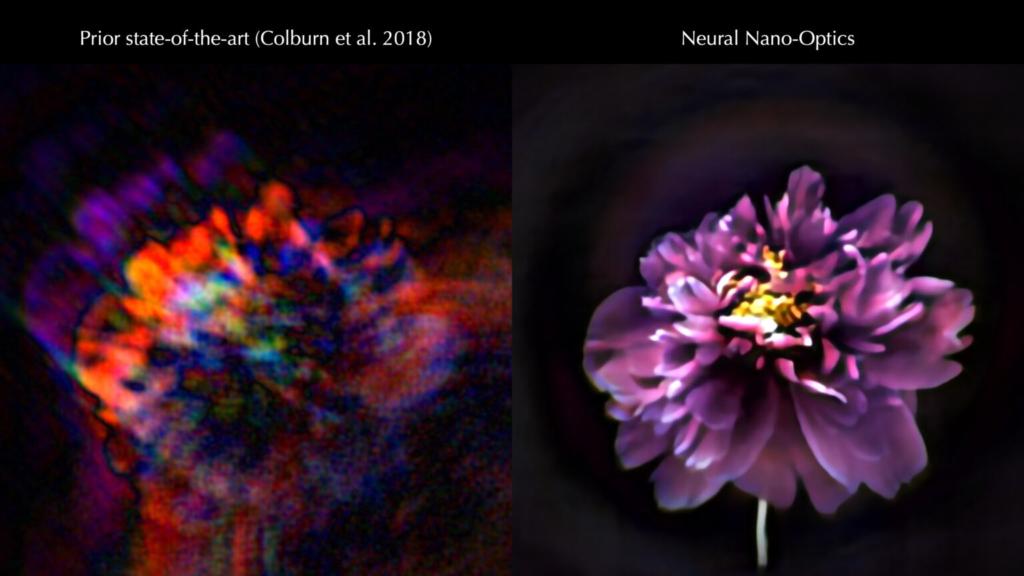Researchers at Princeton University and the University of Washington have developed an ultracompact camera the size of a coarse grain of salt. The system relies on a technology called a metasurface, which is studded with 1.6 million cylindrical posts and can be produced much like a computer chip.
Impacts:
* Next level miniturization
* better blood stream robotics and internal medical imaging
* better smartphones and devices
Micro-sized cameras have great potential to spot problems in the human body and enable sensing for super-small robots, but past approaches captured fuzzy, distorted images with limited fields of view.

The approach to optical design is not new, this is the first system that uses a surface optical technology in the front end and neural-based processing in the back.
Ultracompact imagers could create “surfaces as sensors. Instead of three cameras on the back of your phone, the whole back of your phone would become one giant camera.

Previous micro-sized cameras (left) captured fuzzy, distorted images with limited fields of view. A new system called neural nano-optics (right) can produce crisp, full-color images on par with a conventional compound camera lens. Image courtesy of the researchers
Nature – Neural nano-optics for high-quality thin lens imaging
Now, researchers at Princeton University and the University of Washington have overcome these obstacles with an ultracompact camera the size of a coarse grain of salt. The new system can produce crisp, full-color images on par with a conventional compound camera lens 500,000 times larger in volume.
Enabled by a joint design of the camera’s hardware and computational processing, the system could enable minimally invasive endoscopy with medical robots to diagnose and treat diseases, and improve imaging for other robots with size and weight constraints. Arrays of thousands of such cameras could be used for full-scene sensing, turning surfaces into cameras.
While a traditional camera uses a series of curved glass or plastic lenses to bend light rays into focus, the new optical system relies on a technology called a metasurface, which can be produced much like a computer chip. Just half a millimeter wide, the metasurface is studded with 1.6 million cylindrical posts, each roughly the size of the human immunodeficiency virus (HIV).
Each post has a unique geometry, and functions like an optical antenna. Varying the design of each post is necessary to correctly shape the entire optical wavefront. With the help of machine learning-based algorithms, the posts’ interactions with light combine to produce the highest-quality images and widest field of view for a full-color metasurface camera developed to date.
Abstract
Nano-optic imagers that modulate light at sub-wavelength scales could enable new applications in diverse domains ranging from robotics to medicine. Although metasurface optics offer a path to such ultra-small imagers, existing methods have achieved image quality far worse than bulky refractive alternatives, fundamentally limited by aberrations at large apertures and low f-numbers. In this work, we close this performance gap by introducing a neural nano-optics imager. We devise a fully differentiable learning framework that learns a metasurface physical structure in conjunction with a neural feature-based image reconstruction algorithm. Experimentally validating the proposed method, we achieve an order of magnitude lower reconstruction error than existing approaches. As such, we present a high-quality, nano-optic imager that combines the widest field-of-view for full-color metasurface operation while simultaneously achieving the largest demonstrated aperture of 0.5 mm at an f-number of 2.
SOURCES- Princeton University, Nature
Written By Brian Wang, Nextbigfuture.com

Brian Wang is a Futurist Thought Leader and a popular Science blogger with 1 million readers per month. His blog Nextbigfuture.com is ranked #1 Science News Blog. It covers many disruptive technology and trends including Space, Robotics, Artificial Intelligence, Medicine, Anti-aging Biotechnology, and Nanotechnology.
Known for identifying cutting edge technologies, he is currently a Co-Founder of a startup and fundraiser for high potential early-stage companies. He is the Head of Research for Allocations for deep technology investments and an Angel Investor at Space Angels.
A frequent speaker at corporations, he has been a TEDx speaker, a Singularity University speaker and guest at numerous interviews for radio and podcasts. He is open to public speaking and advising engagements.


On the one hand, it really raises questions regarding the privacy of a person, on the other hand, it will also discipline people to behave better. I think it will also give a step forward in development in everything related to cameras. For example, now there are good security systems like Ajax that help us feel safer and if the cameras become less visible and can process more information, then we will be more protected from robbers, etc., and we will also be able to quickly respond if something happens at home like broken pipes, fire and so on.